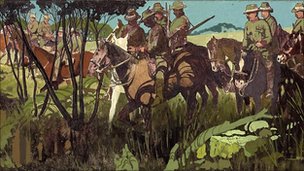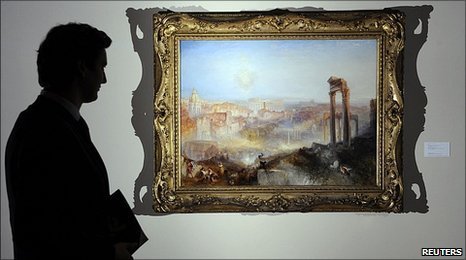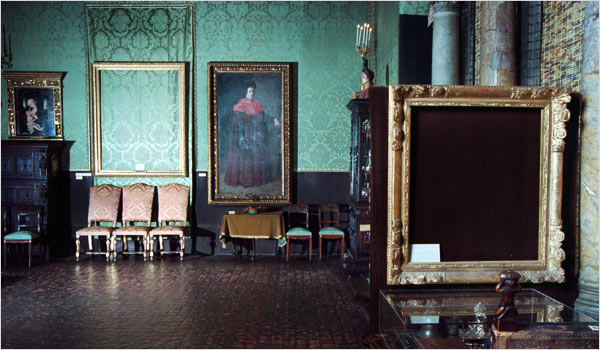On 15 Oct, 2010 With
A 75-year-old Surrey woman cleared out her attic and found two paintings that could fetch up to £30,000 at auction. The woman decided she wanted to throw the oil paintings away, but first went to her neighbour Spencer Wright to ask how to dispose of them. Mr Wright said he realised they should not be consigned to the bin, and used an iPhone app to contact Christie’s. He said a specialist immediately knew the value of the paintings, by Australian artist William Blamire Young. The paintings – Light Horse and Artillery – had been bought by the woman’s father 60 years ago, but were kept in the attic because her mother did not like them. ‘Headed for dump’ Mr Wright…
Read More
On 14 Oct, 2010 With
Portrait of a Woman, attributed to Goya(1746-1828). X-ray images taken of this painting in 1954, revealed a portrait of another woman, circa 1790, beneath the surface. X-ray diffraction analysis revealed the presence ofzinc white paint, invented after Goya’s death. Further analysis revealed that the surface paint was modern and had been applied so as not to obscure the craquelure of the original. After analysis, the conservators left the work as you see it above, with portions of old and new visible, to illustrate the intricacies of art forgery, and the inherent difficulty of detecting it. Art forgery refers to creating and, in particular, selling works of art that are falsely attributed to be work of another, usually more famous, artist. Art forgery is extremely…
Read More
On 13 Oct, 2010 With
An 1839 Turner masterpiece of a view of Rome has sold for £29.7m in London, breaking the artist’s auction record. Modern Rome – Campo Vaccino sold in five minutes with six bidders battling for the work which has only come up for sale once before, Sotheby’s said. The previous record was the £20.5m paid in 2006 for Venice painting Giudecca, La Donna della Salute and San Giorgio. Modern Rome, which had an estimate of £12m-£18m, was the top seller at the Old Master and British Paintings sale. Other highlights included Dutch artist Jan Lievens’ study of the head and shoulders of an old bearded man wearing a cap (circa 1629), which brought £2.5m against an estimate of £2-3m. TURNER AUCTIONS:…
Read More
On 12 Oct, 2010 With
Sitwell, Dame Edith Edith Sitwell Dame Edith Louisa Sitwell DBE (7 September 1887 – 9 December 1964) was a British poet and critic. Background Edith Sitwell was born in Scarborough, Yorkshire, the only daughter of the eccentric Sir George Sitwell, 4th Baronet, of Renishaw Hall; he was an expert on genealogy and landscaping. Her mother was the former Lady Ida Emily Augusta Denison, a daughter of the Earl of Londesborough and a granddaughter of Henry Somerset, 7th Duke of Beaufort. She claimed a descent through female lines from thePlantagenets. Sitwell had two younger brothers, Osbert (1892-1969) and Sacheverell Sitwell (1897-1988) both distinguished authors, well-known literary figures in their own right, and long-term collaborators. Sacheverell married a Canadian woman, Georgia Doble, in 1925 and moved to Weston Hall in Northamptonshire….
Read More
On 11 Oct, 2010 With
White Center (Yellow, Pink and Lavender on Rose) by Mark Rothko • 2007: The second most expensive contemporary (ie. post-war) painting ever sold at auction: White Center (Yellow, Pink and Lavender on Rose) by Mark Rothko. Sold for $72.8 million.
Read More
On 10 Oct, 2010 With
Boston art theft remains biggest unsolved mystery By John Wilson Vermeer’s The Concert is estimated to be worth around £200m The Gardner robbery remains the largest single property theft of all time As crime scenes go, it has got to be one of the most beautiful. The Dutch Room of the Isabella Stewart Gardner Museum in Boston is lined with green silk wallpaper, from terracotta cobbled floor to oak timbered ceiling. On one wall hangs a Van Dyck, on another a Rubens but these artworks are not the first things one notices in the first floor gallery. It is the empty frames that stop you in your tracks. One, an ornate gilded rectangle framing nothing but green wallpaper, once held…
Read More
On 8 Oct, 2010 With
Relational Art Relational Art or “Relational Aesthetics” is a mode or tendency in fine art practice originally observed and highlighted by French art critic Nicolas Bourriaud. Bourriaud defined the approach simply as, “a set of artistic practices which take as their theoretical and practical point of departure the whole of human relations and their social context, rather than an independent and private space.” Origin of the term One of the first attempts to analyze and categorize art from the 1990s, the idea of Relational Art was developed by Nicolas Bourriaud in 1998 in his book Esthétique relationnelle(Relational Aesthetics). The term was first used in 1996, in the catalogue for the exhibition Traffic curated by Bourriaud at CAPC musée d’Art contemporain de Bordeaux. Trafficincluded…
Read More
On 7 Oct, 2010 With
Visionary art is art that purports to transcend the physical world and portray a wider vision of awareness including spiritual or mysticalthemes, or is based in such experiences. Definition The American Visionary Art Museum defines Visionary art as “….art produced by self-taught individuals, usually without formal training, whose works arise from an innate personal vision that revels foremost in the creative act itself.” It goes on to say that visionary art is a product of an inner process, and may not even be thought of as art by its creator; it also differentiates Visionary art from Folk art. Alexander Beiner, host of Visionary Artists Podcast, has proposed an alternative definition, suggesting that “Visionary Art is any art that seeks to represent or explore mystical experience. As…
Read More
On 6 Oct, 2010 With
Jean-Léon Gérôme (May 11, 1824 – January 10, 1904) was a French painter and sculptor in the style now known as Academicism. The range of his oeuvre included historical painting, Greek mythology, Orientalism, portraits and other subjects, bringing the Academic painting tradition to an artistic climax. Life Jean-Léon Gérôme was born at Vesoul (Haute-Saône). He went to Paris in 1840 where he studied under Paul Delaroche, whom he accompanied to Italy (1843–1844). He visited Florence, Rome, the Vatican and Pompeii, but he was more attracted to the world of nature. Taken by a fever, he was forced to return to Paris in 1844. On his return he followed, like many other students of Delaroche, into the atelier ofCharles Gleyre and studied there for a brief…
Read More
On 5 Oct, 2010 With
Dante Gabriel Rossetti. The Pre-Raphaelite Brotherhood (also known as the Pre-Raphaelites) was a group of English painters, poets, and critics, founded in 1848 by William Holman Hunt, John Everett Millais and Dante Gabriel Rossetti. The three founders were soon joined by William Michael Rossetti,James Collinson, Frederic George Stephens and Thomas Woolner to form a seven-member “brotherhood”. The group’s intention was to reform art by rejecting what they considered to be the mechanistic approach first adopted by the Mannerist artists who succeeded Raphael and Michelangelo. They believed that the Classical poses and elegant compositions of Raphael in particular had been a corrupting influence on the academic teaching of art. Hence the name “Pre-Raphaelite”. In particular, they objected to the influence of Sir Joshua Reynolds, the founder of the English Royal Academy of Arts. They called him “Sir Sloshua”,…
Read More




